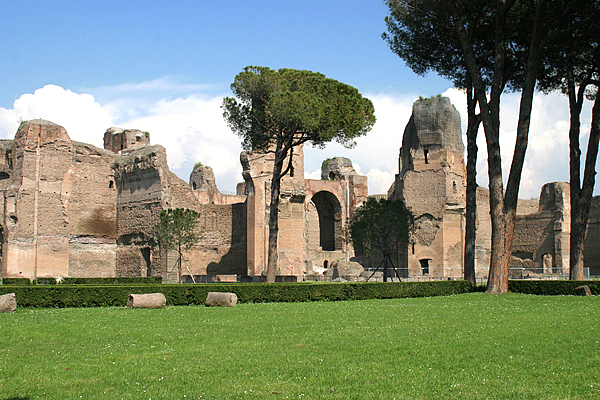

"Among the public works which he left at Rome was the notable Bath named after himself..." Historia Augusta: Life of Caracalla (IX.4)
The Thermae Antoninianae (Baths of Caracalla) were the first great public baths since the Baths of Trajan had been constructed three hundred years earlier. Begun in AD 211 (probably by Septimius Severus, who died that year) and dedicated in AD 216 (Aurelius Victor, XXI), Elagabalus added the peribolus or enclosed court (Historia Augusta, XVII.8-9) that was completed by Alexander Severus (Historia Augusta, XXV.6). Aurelius Victor relates that there were "beautiful fittings" and, indeed, the Belvedere Torso and mosaics of athletes (Vatican Museums), the massive Farnese Bull and Farnese Hercules (Museo Nazionale Archeologico, Naples) all were found there. More prosaically, two large granite basins now serve as fountains in the Piazza Farnese (Rome). According to Olympiodorus (epitomized by Photius, Bibliotheca, LXXX), the soaring ruins once had polished marble seats for 1600 bathers. The baths were in use until the aqueducts that fed them were cut by Genseric the Vandal in AD 537.
"Imagine what a variety of noises reverberates about my ears! I have lodgings right over a bathing establishment. So picture to yourself the assortment of sounds, which are strong enough to make me hate my very powers of hearing! When your strenuous gentleman, for example, is exercising himself by flourishing leaden weights; when he is working hard, or else pretends to be working hard, I can hear him grunt; and whenever he releases his imprisoned breath, I can hear him panting in wheezy and high-pitched tones. Or perhaps I notice some lazy fellow, content with a cheap rubdown, and hear the crack of the pummeling hand on his shoulder, varying in sound according as the hand is laid on flat or hollow. Then, perhaps, a professional comes along, shouting out the score; that is the finishing touch. Add to this the arresting of an occasional roysterer or pickpocket, the racket of the man who always likes to hear his own voice in the bathroom, or the enthusiast who plunges into the swimming-tank with unconscionable noise and splashing. Besides all those whose voices, if nothing else, are good, imagine the hair-plucker with his penetrating, shrill voice,--for purposes of advertisement,--continually giving it vent and never holding his tongue except when he is plucking the armpits and making his victim yell instead. Then the cakeseller with his varied cries, the sausageman, the confectioner, and all the vendors of food hawking their wares, each with his own distinctive intonation."
Seneca, Moral Epistles (LVI)
The photograph above shows the front of the complex, the taller sections once having supported the caldarium. The Baths of Caracalla (1899) is by Sir Lawrence Alma-Tadema.
Reference: Lucius Annaeus Seneca. Moral Epistles (1917) translated by Richard M. Gummere (Loeb Classical Library).